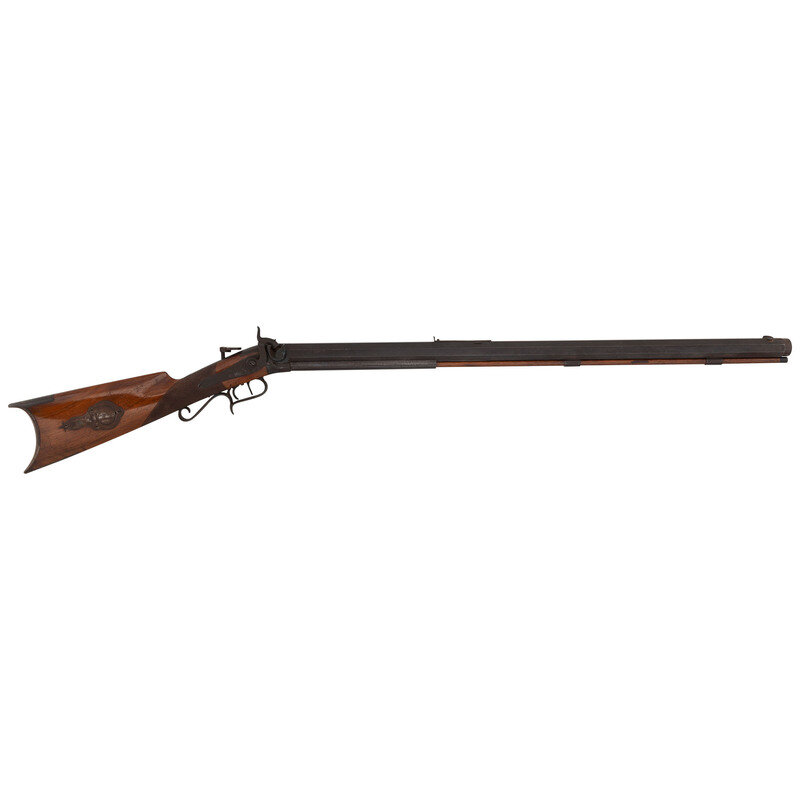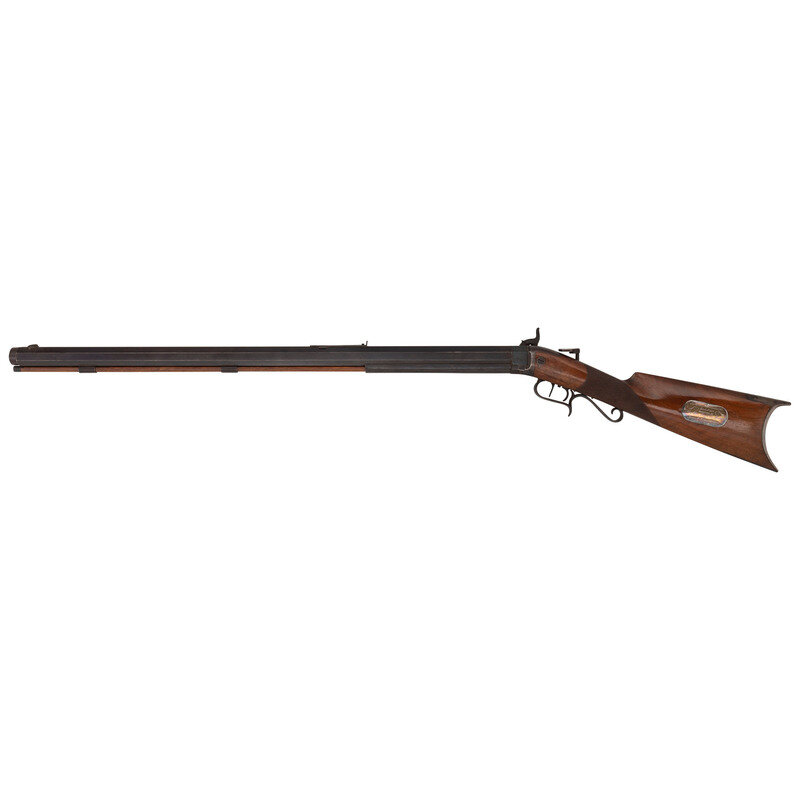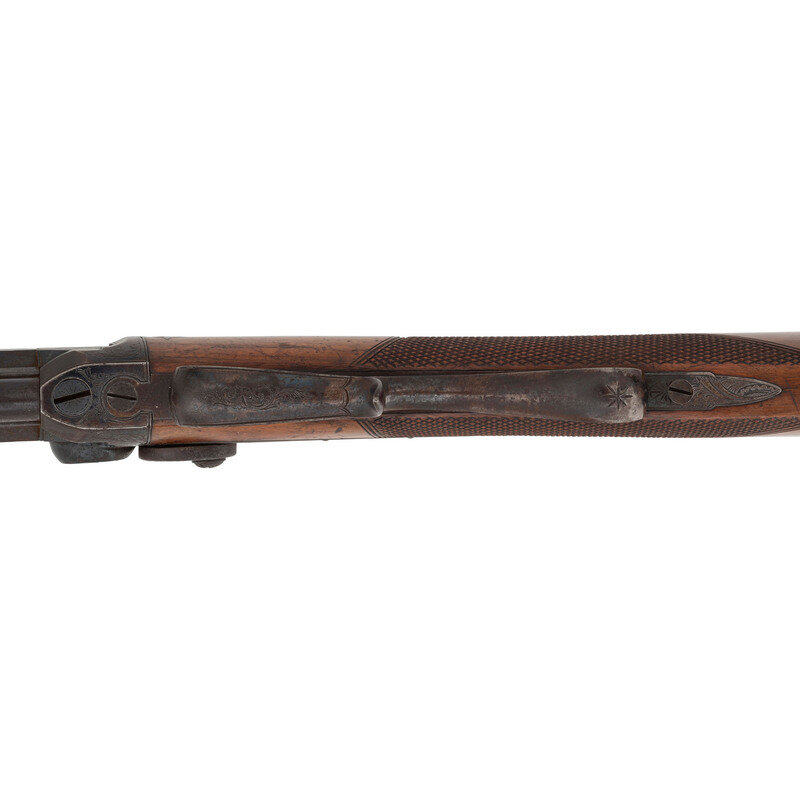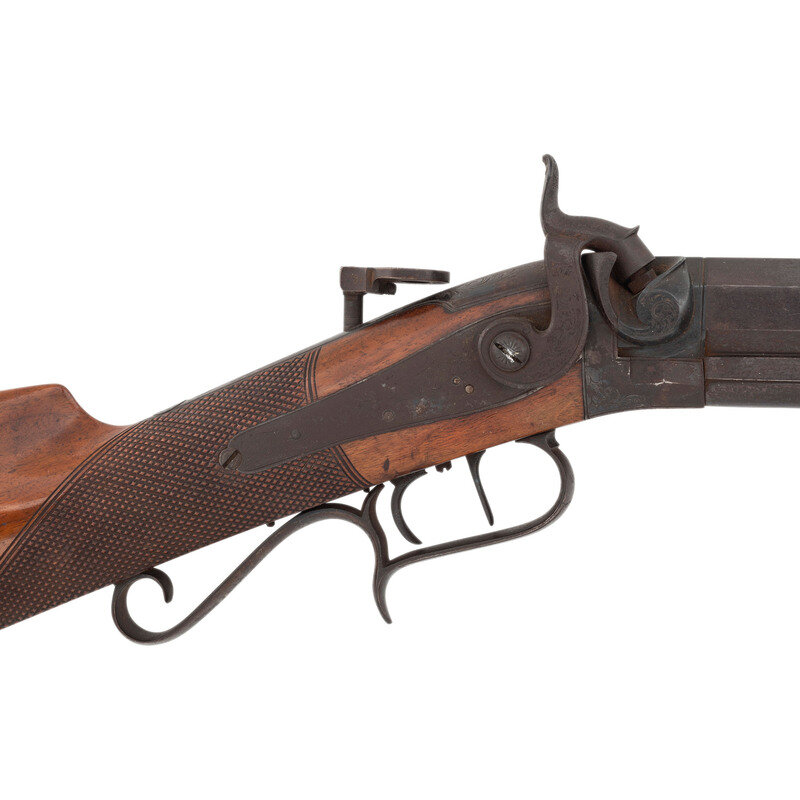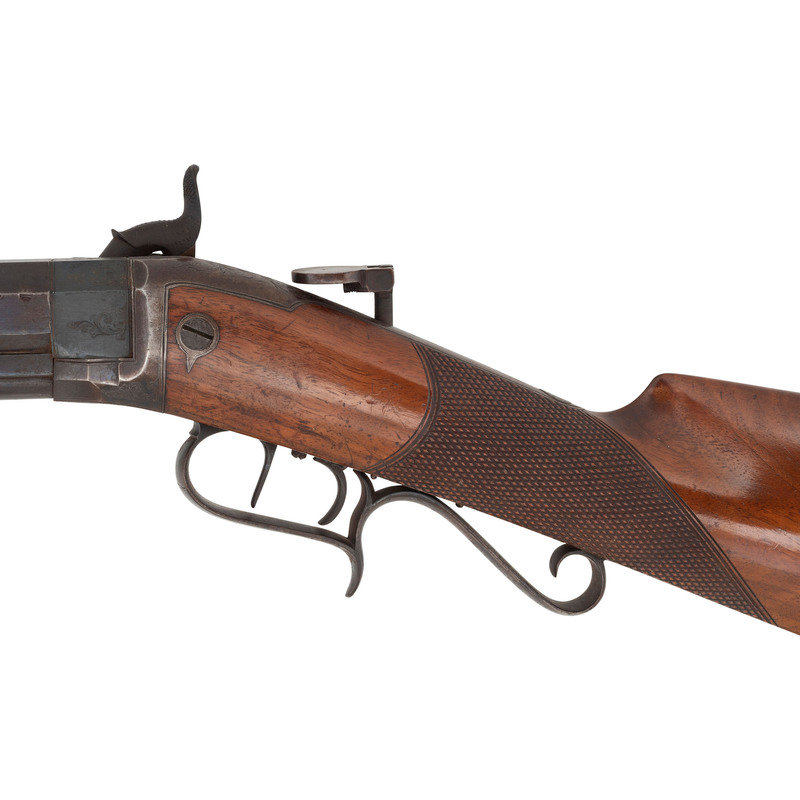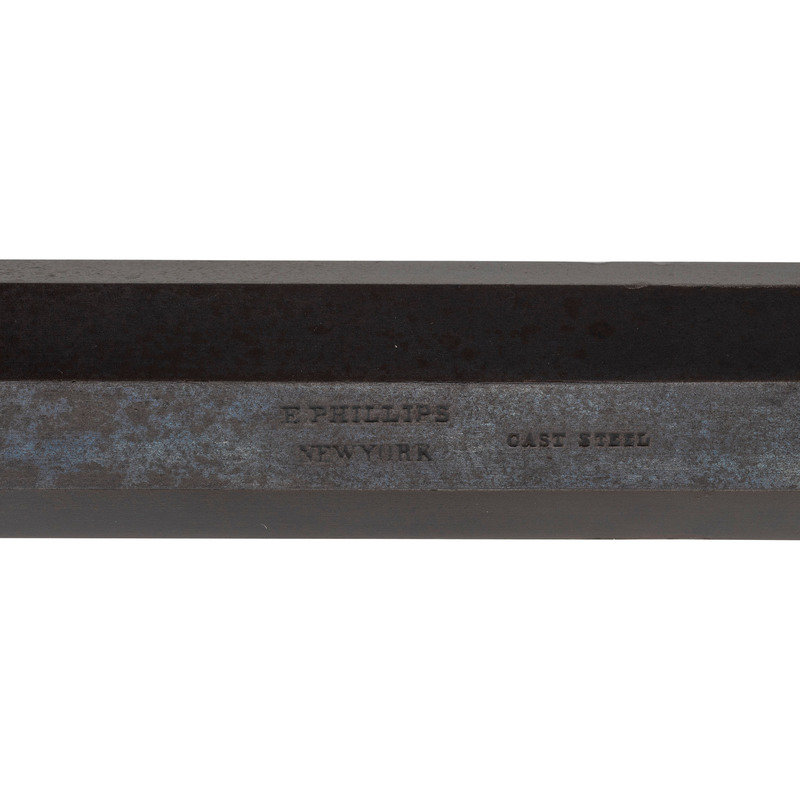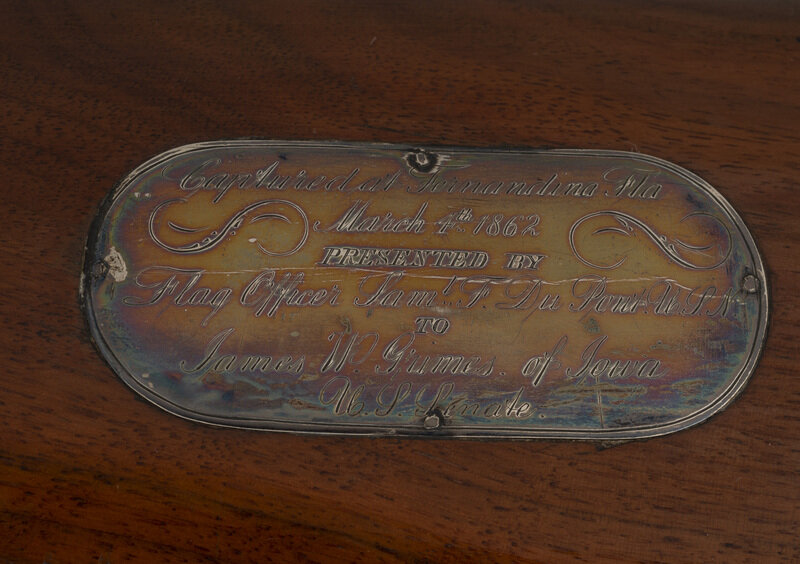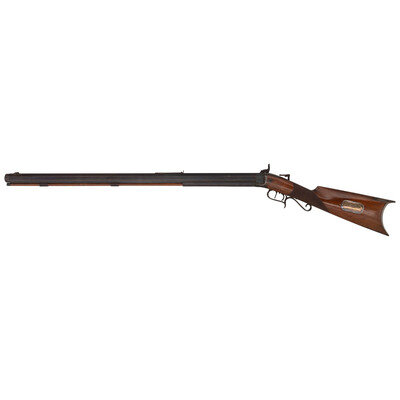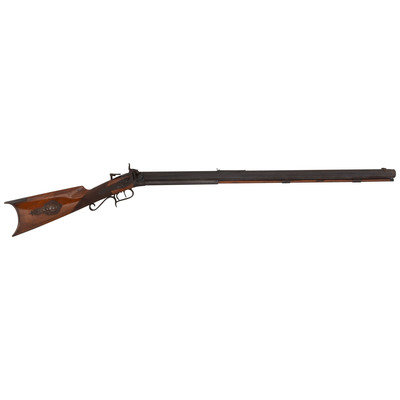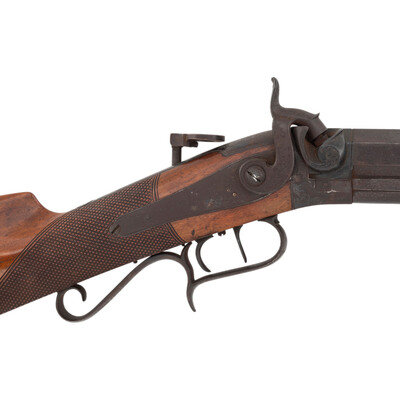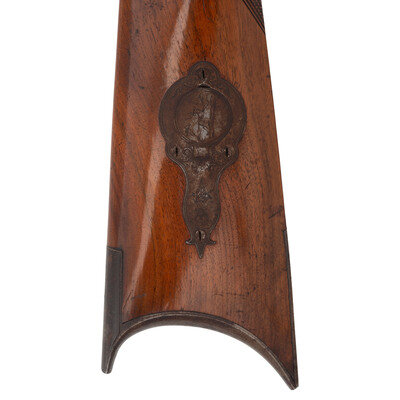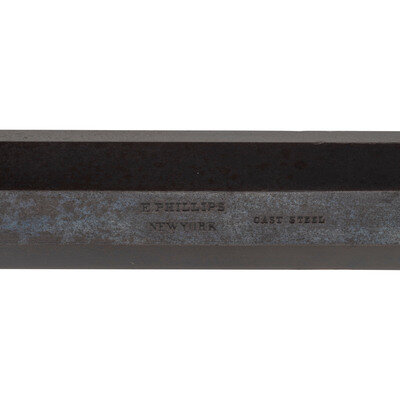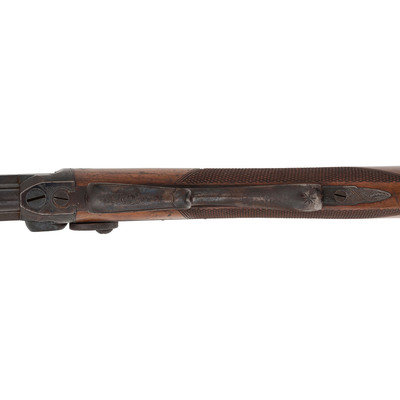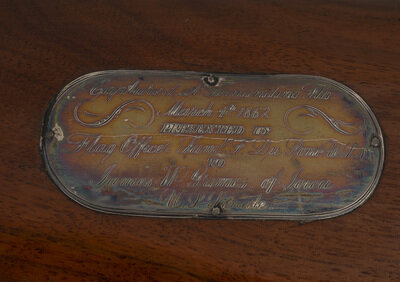Condition Report
Contact Information
Auction Specialists
Lot 44
Lot Description
.40 caliber. 29.75" octagonal barrel. SN: NSN. Blued finish, iron furniture, checkered hardwood stock with crescent butt. Single shot muzzleloading percussion target rifle with flip up tang mounted peep rear sight, barrel mounted leaf rear sight and dovetailed blade front sight. Top barrel flat marked E PHILLIPS/NEW YORK and CAST STEEL. Back action percussion lock with loose foliate scroll engraving with the the frame, breech, breech plug tang, triggerguard and toe plate engraved en-suite. Equipped with double set triggers and an iron patch box with loose foliate engraving and a leaping deer. The patchbox still retains period linen patches. Barrel turned round at the muzzle for a bullet starter. Made without a forend, with a long iron entry pipe and two shorter thimbles retaining what appears to be the original brass tipped wooden ramrod with a concealed bullet puller under a brass cap on the reverse. The rifle is mounted with an oval German silver plaque on the reverse of the butt that is engraved as follows: Captured at Fernandina Fla / March 4th 1862 / PRESENTED BY / Flag Officer Saml. F. Du Pong U.S.N / To James W. Grimes of Iowa / U.S. Senate. Sellers notes that "E Phillips" was a "maker of a percussion sharp-shooter's rifle with a heavy barrel and telescopic sight." Further research indicates that Edwin Phillips worked in New York City during the mid-19th century and was located at 78 Chrystie from 1850 to 1878. This is a classic example of types of the mid-19th century target rifles that were often pressed into service during the early part of the American Civil War as "sharp shooters" rifles.
Samuel Francis DuPont (1803-1865) was a prominent member of the famous DuPont gunpowder family who was born in Bergen Point (Bayonne), NJ on September 27, 1803. He went to see as a midshipman at the age of 12, with an appointment from President James Madison and his first berth was the 74-gun heavy frigate USS Franklin. In 1821 he transferred to the USS Constitution, and then the USS Congress, all as a midshipman. In 1825 he was made a warrant officer and Sailing Master of the USS North Carolina. The following year he was passed to lieutenant and assigned to the 12-gun schooner Porpoise. Over the next twenty years he held a number of different posts, many as the executive officer of such ships as the USS Constellation and and finally as the commander of the USS Warren, USS Perry and the USS Congress. During the Mexican American War he was the commander of the sloop Cyane and worked as part of the California blockading squadron, taking or destroying 30 ships during the war.
After the war he put significant effort into helping the navy modernize, championing the advantages of steam power and helping to establish a rigorous curriculum in math and engineering while he was briefly the Superintendent at the US Naval Academy. DuPont was finally promoted to captain in 1853 and took commander of the USS Minnesota which took the US Minister to China to his post and which was present for the Anglo French assault on the Chinese forts on the Peiho River while trying to force Chinese compliance with western trade policies. In 1860, he escorted the Japanese minster from Japan in the US for three months. With the outbreak of the American Civil War, DuPont was appointed a "flag officer" commanding the South Atlantic Blockading Squadron from his flagship USS Wabash. The "flag officer" designation was changed to Commodore in 1862 and after a series of successful campaigns along the coasts of South Carolina, Georgia and Florida, which enabled the establishment of a strong blockade line, DuPont was promoted to Rear Admiral. He was the first US Navy officer to be given command of a group of ironclad vessels, but their inability to capture Charleston, SC, through no fault of DuPont's, tarnished his reputation and essentially brought his otherwise sterling career to an end.
DuPont died on a trip to Philadelphia on June 23, 1865 at the age of 61. The action referenced on the plaque on the rifle is the capture of the city and port at Fernandina, FL on the east coast, just south of the Georgia state line. Both the harbor and the railroad connections in the town made it a prime place for southern blockade runners to run their loads into, and the capture of this harbor by DuPont's on March 4, 1862 struck a crippling blow to the Confederate smugglers. DuPont was obviously given this rifle after it was captured at Fernandina from surrendering Confederate forces and he then presented it to Senator Grimes. Grimes was at the time the second highest ranking member of the Senate's Naval Committee and would become the Chairman of the committee during his next term. As Grimes was a strong supporter of the navy and in many ways was the voice of Secretary of the Navy Gideon Welles in that committee, his power regarding all things naval was quite significant. No doubt the gift was meant to increase DuPont's standing in the senator's eyes.
The rifle is accompanied by a large binder of information about the two men as well as copies of correspondence between them, which includes discussions of this gun, and copies of images of the men. The rifle descended in the family of Senator Grimes until it was offered for sale by Butterfield & Butterfield on May 12, 1998, at which time it entered the Oldenbourg Collection. A wonderful piece of Civil War naval history, showing the importance of patronage for a rising naval officer, and a memento from a Confederate serving in Florida. Florida related Civil War items are exceptionally rare and highly coveted, particularly those with southern associations.
